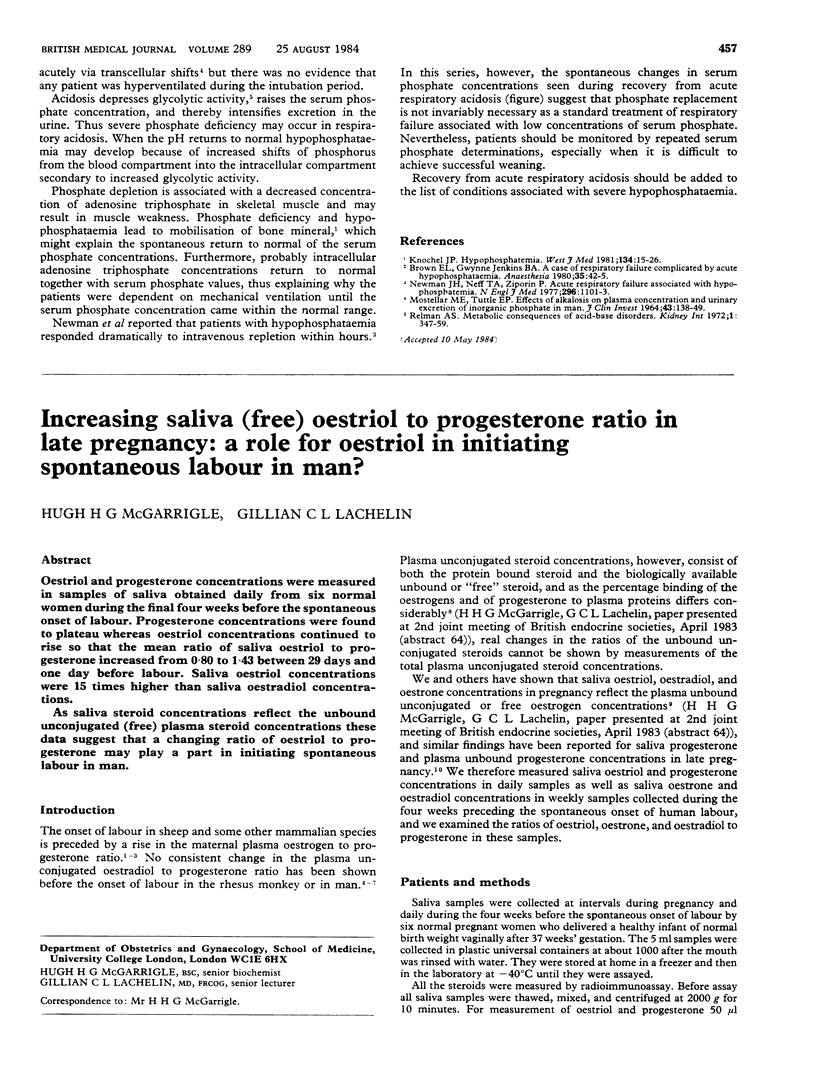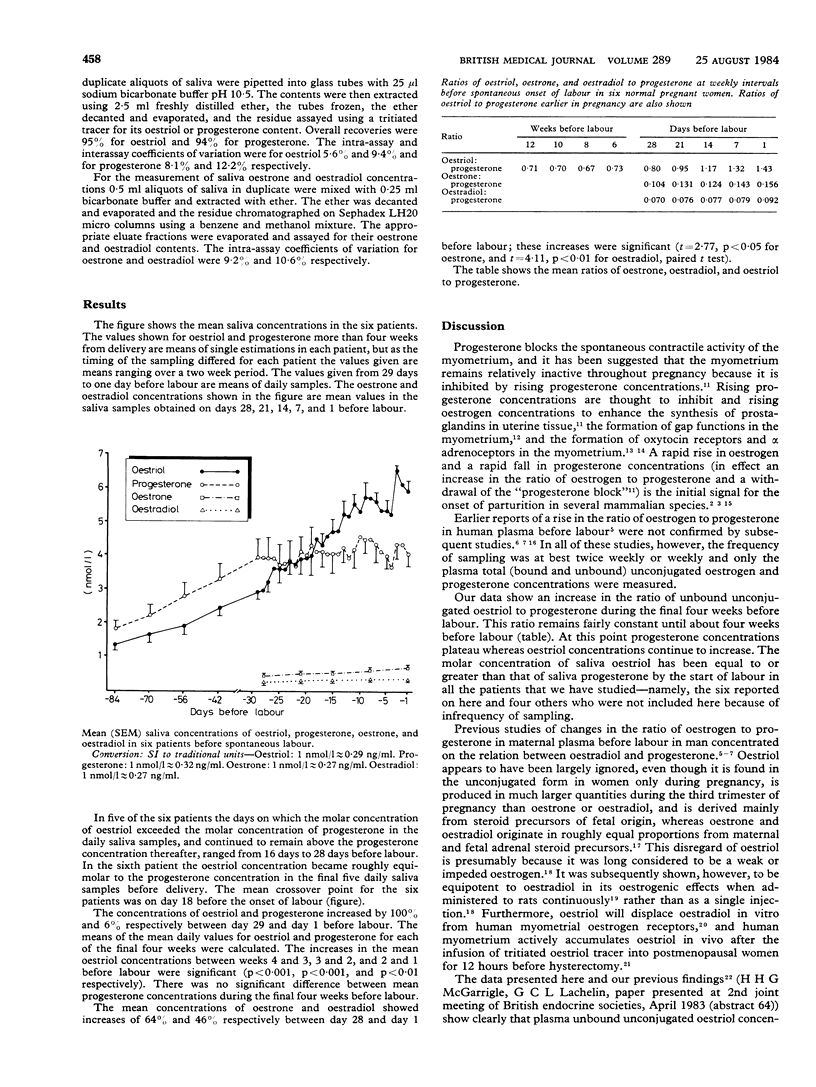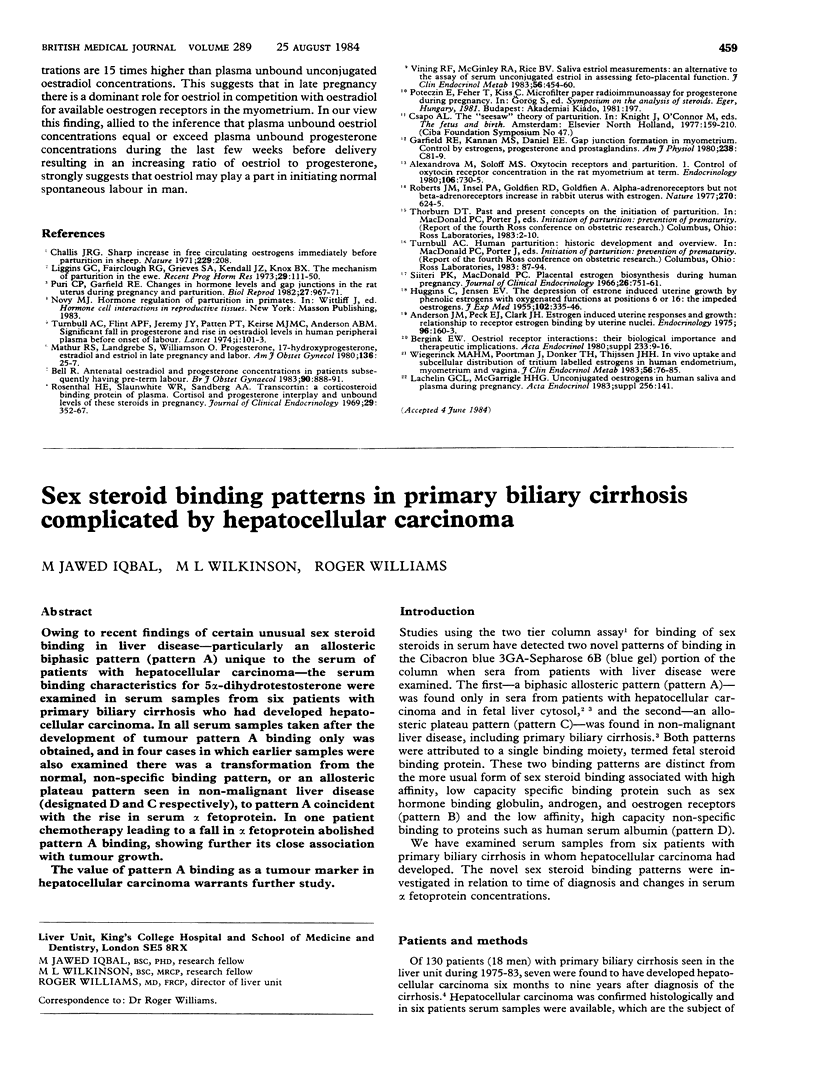Abstract
Oestriol and progesterone concentrations were measured in samples of saliva obtained daily from six normal women during the final four weeks before the spontaneous onset of labour. Progesterone concentrations were found to plateau whereas oestriol concentrations continued to rise so that the mean ratio of saliva oestriol to progesterone increased from 0.80 to 1.43 between 29 days and one day before labour. Saliva oestriol concentrations were 15 times higher than saliva oestradiol concentrations. As saliva steroid concentrations reflect the unbound unconjugated (free) plasma steroid concentrations these data suggest that a changing ratio of oestriol to progesterone may play a part in initiating spontaneous labour in man.
Full text
PDF


Selected References
These references are in PubMed. This may not be the complete list of references from this article.
- Alexandrova M., Soloff M. S. Oxytocin receptors and parturition. I. Control of oxytocin receptor concentration in the rat myometrium at term. Endocrinology. 1980 Mar;106(3):730–735. doi: 10.1210/endo-106-3-730. [DOI] [PubMed] [Google Scholar]
- Anderson J. N., Peck E. J., Jr, Clark J. H. Estrogen-induced uterine responses and growth: relationship to receptor estrogen binding by uterine nuclei. Endocrinology. 1975 Jan;96(1):160–167. doi: 10.1210/endo-96-1-160. [DOI] [PubMed] [Google Scholar]
- Bell R. Antenatal oestradiol and progesterone concentrations in patients subsequently having preterm labour. Br J Obstet Gynaecol. 1983 Oct;90(10):888–891. doi: 10.1111/j.1471-0528.1983.tb06758.x. [DOI] [PubMed] [Google Scholar]
- Bergink E. W. Oestriol receptor interactions: their biological importance and therapeutic implications. Acta Endocrinol Suppl (Copenh) 1980;233:9–16. [PubMed] [Google Scholar]
- Challis J. R. Sharp increase in free circulating oestrogens immediately before parturition in sheep. Nature. 1971 Jan 15;229(5281):208–208. doi: 10.1038/229208a0. [DOI] [PubMed] [Google Scholar]
- Garfield R. E., Kannan M. S., Daniel E. E. Gap junction formation in myometrium: control by estrogens, progesterone, and prostaglandins. Am J Physiol. 1980 Mar;238(3):C81–C89. doi: 10.1152/ajpcell.1980.238.3.C81. [DOI] [PubMed] [Google Scholar]
- HUGGINS C., JENSEN E. V. The depression of estrone-induced uterine growth by phenolic estrogens with oxygenated functions at positions 6 or 16: the impeded estrogens. J Exp Med. 1955 Sep 1;102(3):335–346. doi: 10.1084/jem.102.3.335. [DOI] [PMC free article] [PubMed] [Google Scholar]
- Liggins G. C., Fairclough R. J., Grieves S. A., Kendall J. Z., Knox B. S. The mechanism of initiation of parturition in the ewe. Recent Prog Horm Res. 1973;29:111–159. doi: 10.1016/b978-0-12-571129-6.50007-5. [DOI] [PubMed] [Google Scholar]
- Mathur R. S., Landgrebe S., Williamson H. O. Progesterone, 17-hydroxyprogesterone, estradiol, and estriol in late pregnancy and labor. Am J Obstet Gynecol. 1980 Jan 1;136(1):25–27. doi: 10.1016/0002-9378(80)90558-x. [DOI] [PubMed] [Google Scholar]
- Puri C. P., Garfield R. E. Changes in hormone levels and gap junctions in the rat uterus during pregnancy and parturition. Biol Reprod. 1982 Nov;27(4):967–975. doi: 10.1095/biolreprod27.4.967. [DOI] [PubMed] [Google Scholar]
- Roberts J. M., Insel P. A., Goldfien R. D., Goldfien A. alpha Adrenoreceptors but not beta adrenoreceptors increase in rabbit uterus with oestrogen. Nature. 1977 Dec 15;270(5638):624–625. doi: 10.1038/270624a0. [DOI] [PubMed] [Google Scholar]
- Rosenthal H. E., Slaunwhite W. R., Jr, Sandberg A. A. Transcortin: a corticosteroid-binding protein of plasma. X. Cortisol and progesterone interplay and unbound levels of these steroids in pregnancy. J Clin Endocrinol Metab. 1969 Mar;29(3):352–367. doi: 10.1210/jcem-29-3-352. [DOI] [PubMed] [Google Scholar]
- Siiteri P. K., MacDonald P. C. Placental estrogen biosynthesis during human pregnancy. J Clin Endocrinol Metab. 1966 Jul;26(7):751–761. doi: 10.1210/jcem-26-7-751. [DOI] [PubMed] [Google Scholar]
- Turnbull A. C., Patten P. T., Flint A. P., Keirse M. J., Jeremy J. Y., Anderson A. B. Significant fall in progesterone and rise in oestradiol levels in human peripheral plasma before onset of labour. Lancet. 1974 Jan 26;1(7848):101–103. doi: 10.1016/s0140-6736(74)92337-x. [DOI] [PubMed] [Google Scholar]
- Vining R. F., McGinley R., Rice B. V. Saliva estriol measurements: an alternative to the assay of serum unconjugated estriol in assessing feto-placental function. J Clin Endocrinol Metab. 1983 Mar;56(3):454–460. doi: 10.1210/jcem-56-3-454. [DOI] [PubMed] [Google Scholar]
- Wiegerinck M. A., Poortman J., Donker T. H., Thijssen J. H. In vivo uptake and subcellular distribution of tritium-labeled estrogens in human endometrium, myometrium, and vagina. J Clin Endocrinol Metab. 1983 Jan;56(1):76–86. doi: 10.1210/jcem-56-1-76. [DOI] [PubMed] [Google Scholar]


